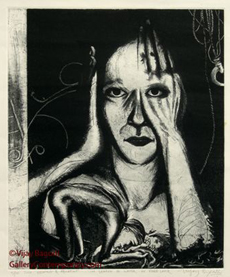|
 |
|
An original print by top Indian
print maker Vijay Bagodi |
New Delhi: Buying art
is no longer the same. Spiralling inflation and shooting prices
are forcing Indian buyers and collectors to settle for the humble
print that strains the wallet a little less.
Prints art, unlike an artist's original one-time creation, can be
replicated in multiple editions. It reaches out to a wider section
of buyers with a price band that can be as cheap as Rs.60,000 to
Rs.70,000 compared to the five-digit prices leading artists
command in the market.
"Works of masters like Picasso, Salvador Dali and Andy Warhol are
available as machine made-prints now. The limited edition original
prints of their works are difficult to procure. The machine
prints, most of which are unsigned, cost much less," artist Jai
Jarotia, a veteran print-maker and artist, told IANS.
Original prints are those made manually in early 20th century
either by the artists themselves or supervised by the artists and
signed in pencil by them.
According to Jarotia, "with more artists becoming popular, there
is scope for print makers to make new works by using print-making
as a technique and replicate it".
"In fact galleries are commissioning original prints by artists -
sometimes even of their own work. I have a commission to make a
plate to reproduce a graphic work of mine. So does veteran print
maker from Vadodara (Baroda) Jyotindra Bhatt," Jarotia said.
People often confuse reproduction art with print, veteran artist
and leading print maker Jyotindra (Jyoti) Bhatt said.
Hence the reluctance to buy prints.
"Reproduction means copying a work that already exists. It is
faithful to the original.
"A print is an original work - a creative process in which an
artist can play around with the colour tones and tints to produce
a totally new effect. It is, however, made by using techniques of
reproduction," Bhatt, 75, told IANS.
The artist, an alumnus of Maharaja Sayajirao University in
Vadodara, added: "The problem is selling the prints. Several
talented print makers have given up prints for painting - because
it makes more money.
"But print makers do not understand that those who can afford art
can afford prints too."
Artist Sobha Broota, who recently returned to her print-making
roots, feels it involves more work than painting.
"I got the opportunity to go back to print making and realised
nothing much has changed except the money (which is not enough).
Print making is more tedious and time consuming - you get more
involved in prints," Broota said.
According to Vijay Bagodi, a noted print-maker and artist from
M.S. University in Vadodara, "the younger lot of print makers use
it in combination with multi-media art as a means of survival."
"We concentrated on print making as students," he told IANS.
Rajan Shripad Fulari, who is in charge of the print making section
at the Lalit Kala Akademi, regretted that "galleries in India do
not make an attempt to sell original Indian prints - unless they
are prints of works by Raja Ravi Varma or some established
artist".
His claim rings true.
A Mayur Vihar-based collector of Salvador Dali's prints said he
orders his prints from the Dali Foundation.
Agrees Gaurav Assomull, CEO of Mumbai-based Marigold Art: "Famous
prints are collectors' items."
"We have a collection of eight hand-signed lithographs of Salvador
Dali priced Rs.6 lakh each. We sold two last year," Assomull said.
According to Saffronart, India's largest online art auction house,
contemporary print-making came to India in the mid-16th century.
Initially, it was used for duplication and reproduction of art;
but in the 17th and 18th centuries, several East India Company
painters - mostly European chroniclers- printed mass editions of
their Indian landscape drawings for sale back home.
The most famous among them were the brothers William and Thomas
Daniell, whose works, "Oriental Scenery" - a collection of 73
aquatints (a print technique) - were exhibited in the national
capital in March.
Traditionally print making involves three broad manual categories
- intaglio method, relief method and planographic method.
The methods include engraving, dry-point etching, mezzotint,
aquatint, woodcuts, linoleum cut, lithograph and serigraph.
Of late, several digital print-making formats have given the genre
a cutting edge.
(Madhusree
Chatterjee can be contacted at madhu.c@ians.in)
|



















